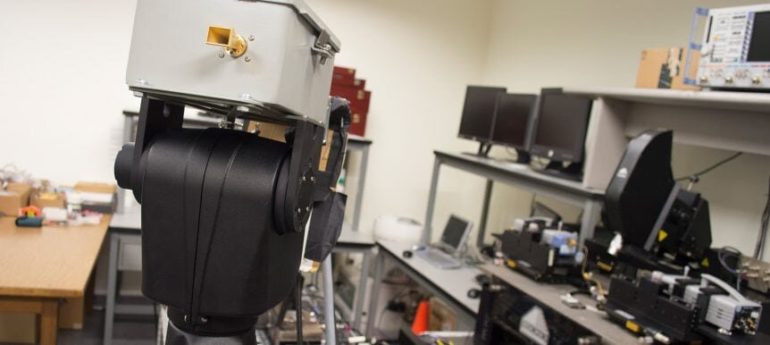Driven by ubiquitous usage of mobile devices and the explosive growth and diversification of the Internet of Things (IoT), sixth-generation (6G) wireless systems will need to offer unprecedented high data rate and system throughput, which can be achieved in part by deploying systems transmitting and receiving at millimeter-wave (mmWave) and Terahertz (THz) frequencies (i.e., 30 GHz—3 THz). These regions of the electromagnetic spectrum are capable of massive data throughput at near zero latency, key to future data traffic demand created by such wireless applications as augmented/virtual reality (AR/VR) and autonomous driving.
Importantly, the linchpin for successful deployment of mmWave and THz systems for 6G wireless communications will be their performance in indoor scenarios. Therefore, accurate THz channel characterization for indoor environments is essential to realizing the designs of transceivers, air interface, and protocols for 6G and beyond.
To this end, NYU WIRELESS has introduced NYUSIM 3.0, the latest version of its MATLAB-based open-source mmWave and sub-THz statistical channel simulation software, enabling the indoor MIMO channel simulations for frequencies from 500 MHz to 150 GHz with RF bandwidth of 0 to 800 MHz. The new NYUSIM 3.0 is publicly available with a simple MIT-style open source acknowledgement license. To date, NYUSIM has been downloaded over 80,000 times.
NYUSIM 3.0 implemented a 3D indoor statistical channel model for mmWave and sub-THz frequencies following the mathematical framework of the 3D outdoor statistical channel model adopted in earlier versions of NYUSIM. The indoor 3D statistical channel model for mmWave and sub-THz frequencies, was developed from extensive radio propagation measurements conducted in an office building at 28 GHz and 140 GHz in 2014 and 2019—in both line-of-sight (LOS) and non-line-of-sight (NLOS) scenarios. The team carefully measured over 15,000 power delay profiles to study temporal and spatial channel statistics such as the number of time clusters, cluster delays, and lobe angular spreads.
The adopted channel models for Version 3.0 are elaborated in a upcoming paper, “Millimeter Wave and Sub-Terahertz Spatial Statistical Channel Model for an Indoor Office Building” (to appear in IEEE Journal on Selected Areas in Communications, Special Issue on Terahertz Communications and Networking in the second quarter 2021) by a team of three students at NYU WIRELESS, and the Department of Electrical and Computer Engineering under Rappaport’s guidance, led by Ph.D. student Shihao Ju. Besides proposing a unified indoor channel model across mmWave and sub-THz bands based on the team’s indoor channel measurements, the work provides a reference for future standards development above 100 GHz.
Millimeter wave photonics with terahertz semiconductor lasers
More information:
Millimeter Wave and Sub-Terahertz Spatial Statistical Channel Model for an Indoor Office Building. arXiv:2103.17127v1 [cs.IT] 31 Mar 2021, arxiv.org/abs/2103.17127
Provided by
NYU Tandon School of Engineering
Citation:
Millimeter wave and sub-terahertz spatial statistical channel model for an indoor office building (2021, April 5)
retrieved 5 April 2021
from https://techxplore.com/news/2021-04-millimeter-sub-terahertz-spatial-statistical-channel.html
This document is subject to copyright. Apart from any fair dealing for the purpose of private study or research, no
part may be reproduced without the written permission. The content is provided for information purposes only.



